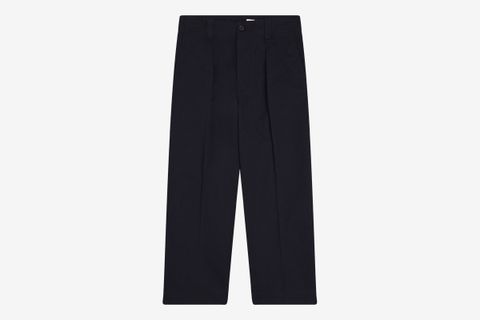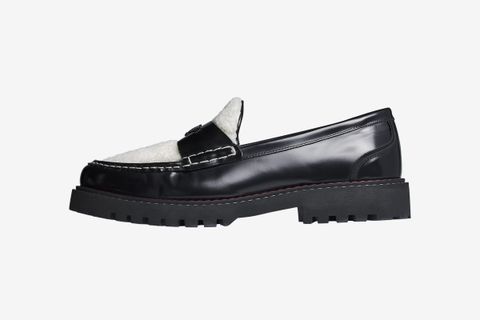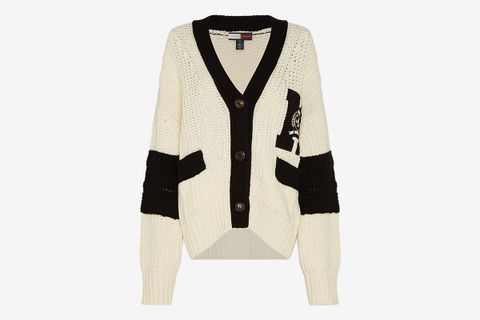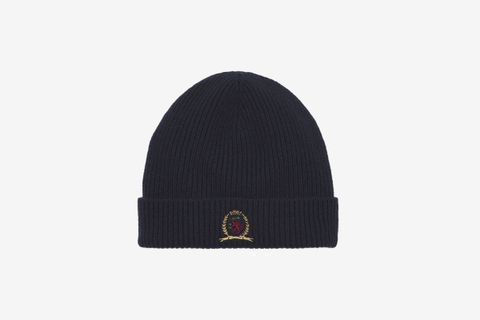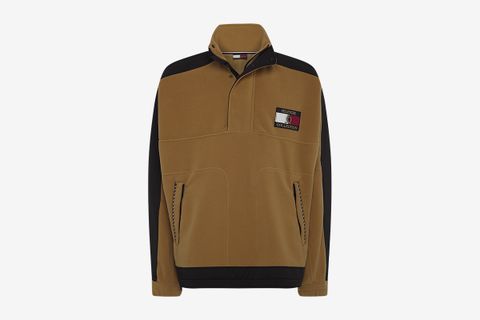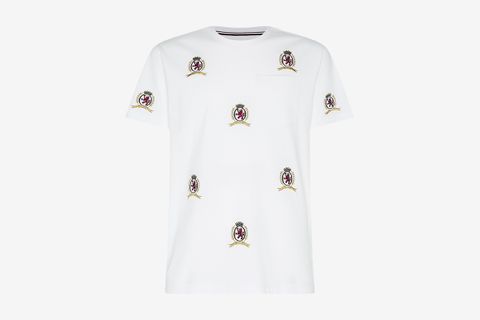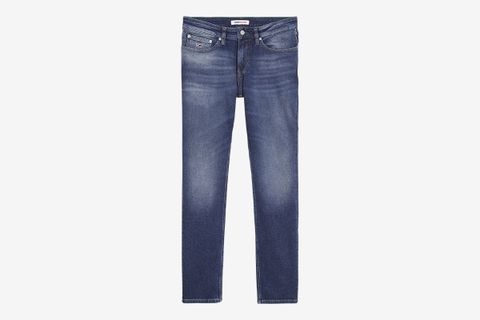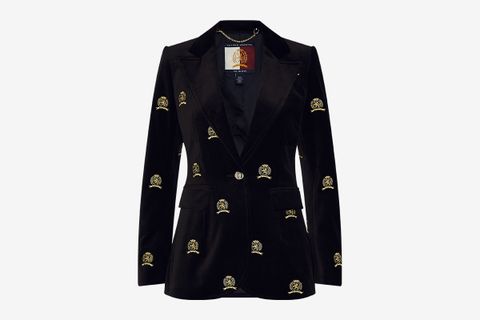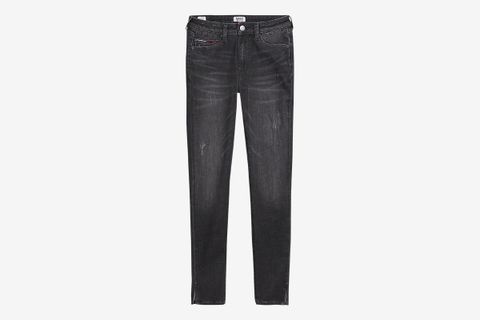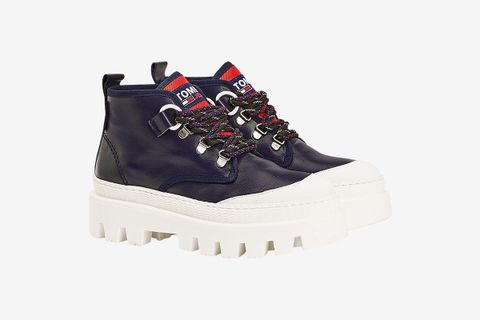Fame has never eluded legendary designer Tommy Hilfiger. No, we’re not talking about that kind of fame. We’re talking about “F.A.M.E.S.” — Hilfiger’s design philosophy revolving around five core pillars that serve as a constant source of inspiration: fashion, art, music, entertainment, and sports. It’s how Hilfiger has been able to become synonymous with classic all-American style ever since his namesake brand was founded in 1985.
Hilfiger, however, has never been one to shy away from interests beyond the design studio. He’s a huge supporter of the arts and has a private collection featuring works from some of the greatest American artists of all time, including Andy Warhol, Jean-Michel Basquiat, and Keith Haring. Hilfiger often blurs the boundaries between the art and fashion worlds, as he did in 2017 when the experiential TOMMYNOW show gave a platform to local graffiti artists to design parts of the runway.
His connection with music has also been well documented and some of Hilfiger’s earliest designs were inspired by album covers from The Beatles and Jimi Hendrix. Rock legends of yore had undeniably unique style and this fascinated Hilfiger. That’s probably why he’s sponsored the tours and albums of some of the most influential artists of our time, including The Rolling Stones, Britney Spears, Sheryl Crow, and Lenny Kravitz. The Rolling Stones x Tommy Hilfiger No Security tour merchandise from 1999 is as iconic as it is notable — he was in the music merchandise game long before it was cool.
As Tommy Hilfiger celebrates its 35th anniversary, we paid a visit to the Tommy archives in New York City and paired some of Hilfiger’s favorite archival pieces with our own picks from the latest Fall collection. We also spoke to Hilfiger himself to see how the brand has evolved and where it’s going in the future, how those iconic music collaborations came about, his inspiration behind the Fall 2020 collection, and much more.
This interview has been edited and condensed.
Could you explain your team’s approach when designing this season’s collection?
The vision is established early on by a group of us and the team will put together a big storyboard. They'll go into the archive and put together a lot of images and different ideas that would fit into that overall vision. Many times, it really goes back to our roots, but the idea is that it will go back and then go way forward. And by going way forward, we're going into sustainability in a major way. We want to be much more modern as we evolve. We also want to incorporate technology into everything we're doing.
The Tommy Hilfiger brand was founded on preppy classics; where do you see the brand going in the future?
We never want to abandon our roots, but we also realize that in order to stay relevant, we always have to evolve forward and be a step ahead of where the competition might be in silhouette, fabric, detail, and the whole vibe of the collection. We’re also detail-obsessed. We want to make sure every garment has functional detail that could act as a surprise inside of a garment or as something very functional on the outside.
What are some of your favorite Tommy pieces or collections that you designed?
I'm still obsessed with the sailing gear we did in the early '90s because it's functional and it's fashionable. It was created from a lack of finding what we wanted in the world. We could find functional garments, but they weren't stylized in any way. We could find stylized garments but they didn’t have function. So, we wanted to blend function and style together, and that's what happened when we developed sailing gear. The sailing gear was built to really work in weather — work as sailing gear actually — but it became a street fashion trend.
We were really the first street brand. In the late '80s, when we were doing more athletic-inspired outerwear and pieces for Tommy Jeans, it became the streetwear of choice for skaters, rappers, and the whole cultural crowd.
Visiting the Tommy Hilfiger archive must be a walk down memory lane. Are there any fashion moments that stand out as being the most iconic or special?
When I go into the archive, I always have to look at the very first pieces, because there's a memory and an emotion attached to the first pieces that I designed for myself to wear. At that time, preppy was kind of boring, it wasn't cool. I wanted to make it really relaxed and laid back, but I also wanted it to have function. So, I'm very fond of the early, early styles.
The hangman ad that debuted with the brand in 1985 was genius — what’s the story behind it? (pictured in the graphic T-Shirt above, left)
I met this advertising genius by the name of George Lois and told him what I wanted to do. "I'd like to go out to the Hamptons and photograph some models on a beach blowing in the wind," and because my garments were oversized, I wanted them to really look oversized. He said, "That's a stupid idea. Everybody does that. Why do you want me to do something everybody else does?"
George came into my office three days later and had these boards. At the time, the [major] designers were Georgio Armani, Ralph Lauren, Calvin Klein, and Perry Ellis. He took the names off the advertisement and said, "Now, name which is which?” I said, "You can't put other people's names or initials in advertising. They'll think I'm out of my mind trying to compare myself to them." He said, "That's called disruption. You want people to know who you are and that you have a brand, and you want people to go see the clothes. If you don't do something like that, it'll take you 20 years and many millions of dollars to become known."
They talked me into it and it made history. People wanted to see what the clothes looked like. They came to my shop on Columbus Avenue and they liked the clothes. We were also in Bloomingdale's and Saks Fifth Avenue and all these stores, so the business started taking off.
Shop the Look
Your brand has always been heavily influenced by sports. Tell us more about that connection.
I've always been obsessed with sports uniforms. When I was an early teen, I worked in a sporting goods shop owned by Gwyneth Paltrow's uncle called Pal's Sporting Goods. I used to look at all the baseball, football, [and] hockey uniforms and loved the way all of the letters and numbers were sewn on. I liked the strength of the material and I liked the different colorways — I was obsessed with it.
So, when I started doing my whole preppy thing, I thought the sports look was missing from it. I started designing sports uniforms and created my own team uniforms. That's when we started doing really oversized hockey jerseys, football jerseys, basketball jerseys, and it caught on in a major way. That led me into doing big logos, I was criticized for it, but those logos acted as billboards on the streets. When P. Diddy and Snoop wore my logos, it was the best marketing and advertising anybody could think of. Everything was scaled way oversized and done for the street.
Tommy HilfigerI was the only brand doing big logos in the early '90s. Nobody had ever thought of it or done it, and I was being criticized for it, but those logos acted as billboards on the streets.
Tommy Hilfiger was in the music merchandise game long before it was cool, how did that Rolling Stones collaboration come about?
Before I started Tommy Hilfiger, I started my own business called People's Place in 1969. I was obsessed with rock music at the time — Jimi Hendrix, Led Zepplin, The Who, Rolling Stones. I met the Rolling Stones and we became friendly. When they started their tour, we talked about collaboration and designed clothes for them, and also sponsored it.
As Tommy Hilfiger celebrates its 35th anniversary, how has the brand’s aesthetic evolved over time?
It's always evolving. I never want to abandon the roots, but I always want to modernize. Our fits are now slimmer, in some cases. Tommy Jeans is for a younger crowd, so it's more oversized and street-inspired. As a lifestyle brand, we do everything from tailored clothing, to childrenswear, to adaptive apparel, to sport. We basically do everything now, but we’re always evolving and modernizing without losing our roots.
Is there a certain decade or fashion trend that resonates with you the most? How do you incorporate that into your more recent collections?
I love the '70s. It was a time when I was having an incredible amount of fun. Studio 54 was my regular evening hangout and being in the East Village on St. Mark's Place you would see Jimi Hendrix, David Bowie, and all these cool people on the streets. It was an inspirational time because there was a fashion music revolution taking place in front of my eyes. When we did the collaboration with Zendaya and I asked her what she really wanted to do in clothing, she brought me all these ideas that were rooted all in the '70s. So that was really exciting.
What are your proudest moments and milestones during the brand’s 35-year history?
I always wanted to be successful enough to have the wherewithal to make a difference in people's lives. So, when I made my first million dollars, I built a community center in my hometown of Elmira, New York for underprivileged kids. That was such a high for me. It was such a great feeling because when I was growing up our family didn't have a lot of money and I knew what it was like to struggle.
I decided then to become involved with the Fresh Air Fund – we opened up Camp Tommy in 1999, and since then over 10,000 NYC boys have experienced summer in upstate NY, which is very different from what they are used to living in the city. Our foundation has also been very involved in breast cancer, AIDS, and MS.
I'm very proud of the generous and charitable part of my existence. I'm also proud we're still growing and still a very strong brand. I know brands go in and out of fashion and sometimes don't last, so the fact that we're still going strong makes me very proud.
